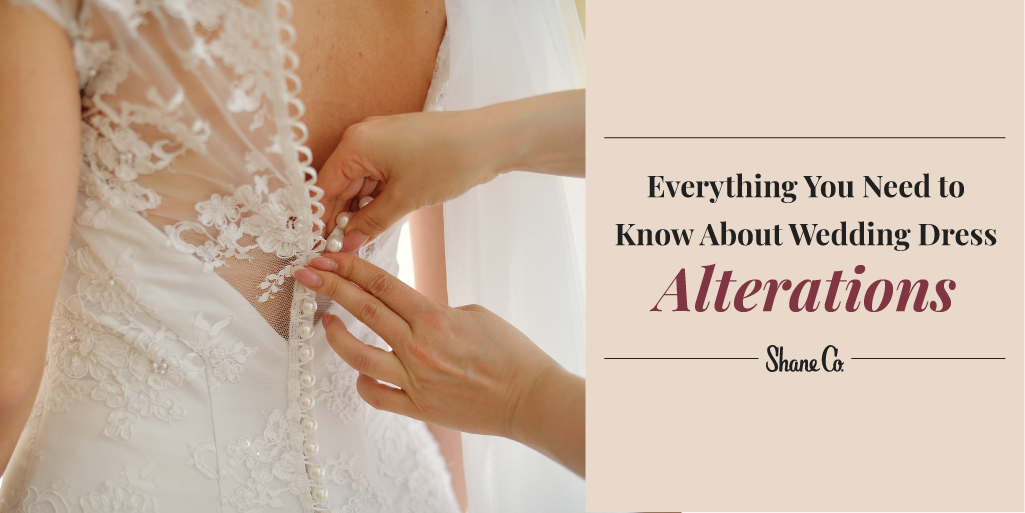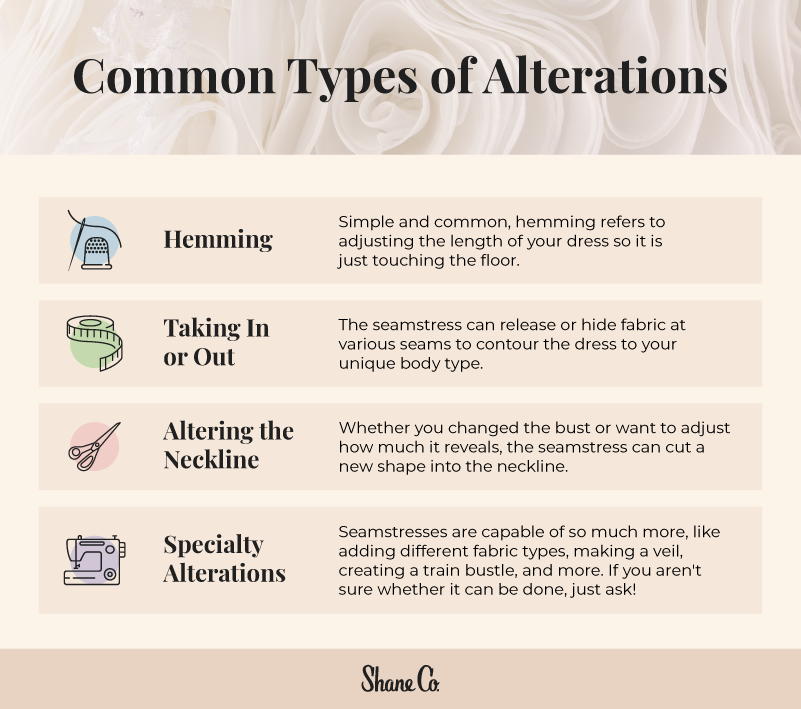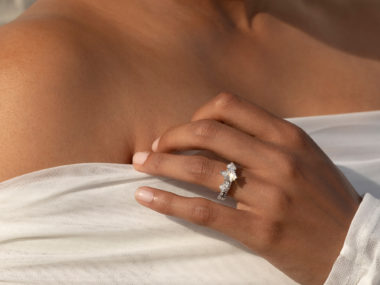
The bride walks down the aisle, beaming in a gown that looks like it was sewn specifically for her by fairy-tale seamstresses. She takes everyone’s breath away, drawing smiles, coos, and tears from the audience. By the time she reaches the altar, the groom is nearly in pieces. It’s the moment many women dream of experiencing, and one that won’t come to fruition without one of the most important pieces of wedding prep — bridal alterations.
Whether your own wedding is on the horizon or your curiosity spiked after coming off a “Say Yes to the Dress” binge, you probably know that the only way to achieve that magical aura is to have your dress customized to your unique body shape and personal style. This article walks you through everything you need to know about wedding dress alterations, so your gown can look as good as your wedding band on your big day!
Are Wedding Dress Alterations Always Necessary?
In short, yes! Because everyone’s body is different, dresses are available in general sizing and intended for fine-tuning after purchase. Maybe you have a large bust and narrow hips, or the other way around, and you need to order your dress in a larger size to remove material where it is in excess. Any dress bought off the rack (or made to order) needs to be altered to fit seamlessly with your unique figure.
A well-fitted gown should support and shape your bust and accentuate your curves with the hem just kissing the floor as you glide down the aisle. This gives off a magical effect on your big day — but magic can become a mishap if the gown is too long and causes you to trip. Most factory dresses come with a generous bust and additional length so that taller women can customize them to their liking. It is harder to add material to a gown than remove it.
How Much Will Bridal Alterations Cost?
There are too many variables to estimate a standard range that you can count on paying for wedding dress alterations. It depends on how involved your changes are, where you live, who you choose to perform the sewing, and other factors.
For example, some fabrics are more challenging to work with than others and are more expensive to alter. Expect to pay a premium for materials like georgette, charmeuse, and chiffon — and consider hiring a seamstress who is at the peak of her craft. On the other hand, go wild with linen, lace, and shantung changes, as these are easier fabrics to alter, even for less experienced seamstresses.
Choose what works best for your budget and your wedding gown. Some seamstresses charge a la carte for specific alterations, while others work on a flat fee. If we had to put a number on it, you might end up forking over $400 to $900 for alterations. It’s a good idea to factor this into the cost of your dress when trying them on in the bridal salon.
Pro Tip: You don’t have to go with the alteration services made available by the bridal shop. Going with a local professional is a great way to save money without skimping on quality.
How Many Wedding Dress Fittings Will I Need?
Typically, bridal alterations require three fittings to plan out the changes to the garment, review the changes, and make any final adjustments (did you decide last-minute that beauty is not pain and trade those stiletto heels for trendy sneakers?). Your timeline may vary depending on how quickly you’re planning a wedding and any other unique circumstances, but starting with a standard timeline is healthy for your stress levels and work-life balance while planning a wedding. Here’s what to expect and when from each visit to the seamstress.
First Fitting
During your initial visit, expect to spend about an hour with your seamstress planning all the changes you’d like to make to the dress. The seamstress will take measurements to alter the bodice (the portion of your dress that covers your torso from neck to waist) and then discuss custom alterations with you.
Using the plans you made together, the seamstress will make the changes to your garment before your second fitting. The first appointment typically takes place three months before your wedding.
Second Fitting
Now that the seamstress has had time to work her magic on your fairy-tale gown, it’s time to go and try it on. Exciting! This fitting is all about reviewing the work done from the first planning session and taking any measurements for adjustments. This appointment shouldn’t take as long since the dress is getting closer to its final form.
At the second fitting, make sure the dress is perfect in front of the mirror and in action. Feign walking up and down the aisle, dance around, and sit down to make sure everything feels right and stays where you want it to throughout your wedding night.
However, don’t stress if the gown still falls short of your perfect vision and you still want significant alterations. This is more common than you think, and that’s why we recommend scheduling this fitting for one month ahead of your big day. Don’t be shy; speak up about what needs to be changed, and the seamstress will take care of everything!
Third Fitting
This is it — the big reveal! Your dress should be complete by this point. You may not get to take the dress home with you yet if there are final tweaks or missed details to correct, but in most cases, your dress is ready to take everyone’s breath away!
In exceptional circumstances, like if you had additional major alterations to make at your second (or third) fitting, you should consider a fourth fitting. These situations aren’t always easy to predict, so it’s essential to give yourself as much leeway as possible when you plan out your timeline for bridal alterations.
How Should I Prepare for Wedding Dress Fittings?
You wouldn’t go sandal shopping in thick wool socks, and you shouldn’t attend your wedding dress fittings unprepared either! Try to emulate your final wedding look as closely as possible — right down to your undergarments! No, seriously, wear the shoes, shapewear, and undergarments you intend to wear on your big day.
Don’t sweat it if you don’t have your shoes picked out yet. Just figure out your ideal heel height early on and wear something similar to your final iteration. And while you don’t have to spend a lot on professional makeup for your fitting, it’s helpful to have your makeup done at a local salon and do your hair to help sell the illusion of walking down the aisle.
What Are the Most Common Wedding Dress Alterations?
So you can tell something is slightly off about your wedding gown but can’t quite place what it needs? Here are a few common wedding dress alterations to help give you the vocabulary to discuss things in detail with your seamstress.

Hemming. Hems are the edges of a dress or garment that are turned over and sewn to prevent fraying. A seamstress can adjust how much fabric is turned over to shorten or lengthen the hem, adjusting the length of the dress to suit your build and frame. Hem alterations typically involve shortening, as most designers build additional length into their dresses to fit taller customers.
Taking out and taking in. Taking out fabric refers to releasing hidden material at various seams of the dress, increasing its size in areas where the bride-to-be has more pronounced features. Taking in is the opposite, where seams are resewn for a smaller fit. You might expect to take in the fabric around the bust, as many dresses come off the rack ready to accommodate a curvier silhouette. Other common areas to take in or out are the hips and waist.
Altering the neckline. If you made a major alteration to the bust, chances are the neckline no longer lays properly. Even if the bust size was perfect right off the rack, neckline alterations allow you to control how revealing the neckline is — or isn’t. Neckline alterations are an easy way to make a big impact on the overall look of your dress.
Specialty alterations. While the above alterations generally cover the basic material adjustments to achieve the perfect fit, there is so much more you can do to your wedding dress if that’s what you want. A talented seamstress can add lace, sleeves, or even a train to your gown. They can make you a veil, sew cups into the bodice, add a waist stay, insert a bustle — and essentially redesign your dress.
Is There a Limit to Wedding Gown Alterations?
There isn’t a limit to the number or extent of alterations you can make to your dress, besides a few minor limitations depending on the fabric and whether you bought it off the rack or made to order. Overall, a talented seamstress can go wild without fear of ruining your dress — but don’t pick just anything off the shelf and expect your seamstress to essentially sew you a completely new design.
Ask questions about what alterations are possible when purchasing the dress, try to find something close to the right fit, and remember that it is easier for your seamstress to remove material than to add it. While it’s possible to order more fabric from the designer in times of need, this could add a significant amount of time to the alterations process.
What Should I Discuss With My Seamstress?
It’s important to find a well-reviewed seamstress with great communication skills. Consider looking for someone that other brides have had positive experiences with, taking into account online testimonials and ratings. Before the first stitch is sewn, you’ll want to get on the same page about a few things.
- Set realistic expectations for the work to be done. Bring photos or drawings to help convey your ideal vision and discuss whether it is feasible to accomplish under budget and time constraints.
- Agree on specific timelines for fittings and delivery of the dress, and give yourself plenty of runway in case it doesn’t turn out how you wanted.
- Understand your seamstress’ protocol in case the dress gets ruined in her care, isn’t delivered on time, or is altered in a way that you’re not happy with and can’t be undone.
Final Thoughts
We hope this guide prepares you to confidently navigate your wedding dress alterations and enjoy the special moment, whether all eyes will be on the bride or you decided to elope. For tips and advice on other matters of wedding preparation, visit our blog to learn more about what you’ll place on your fingers, from gold wedding bands to different kinds of rings for men.


